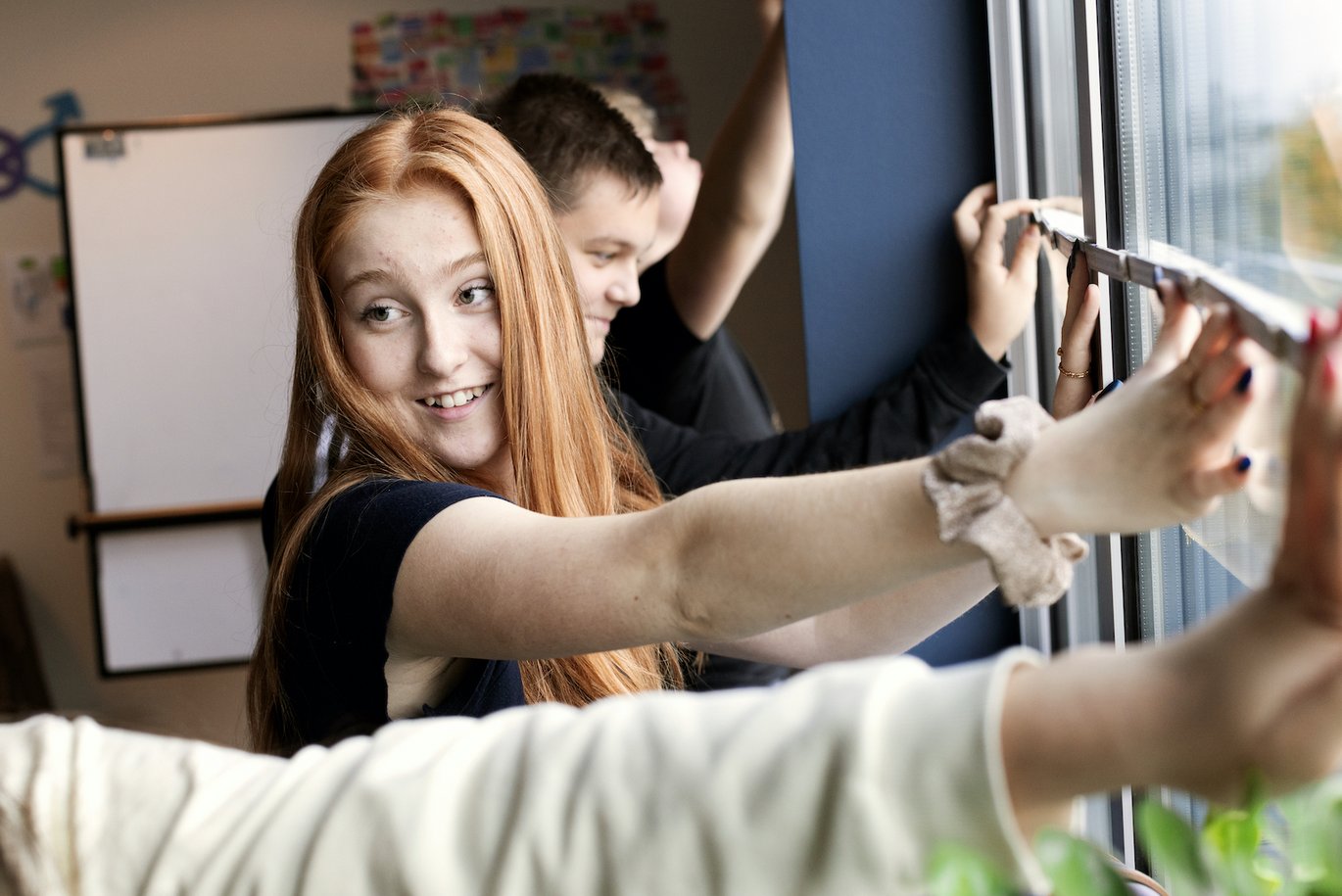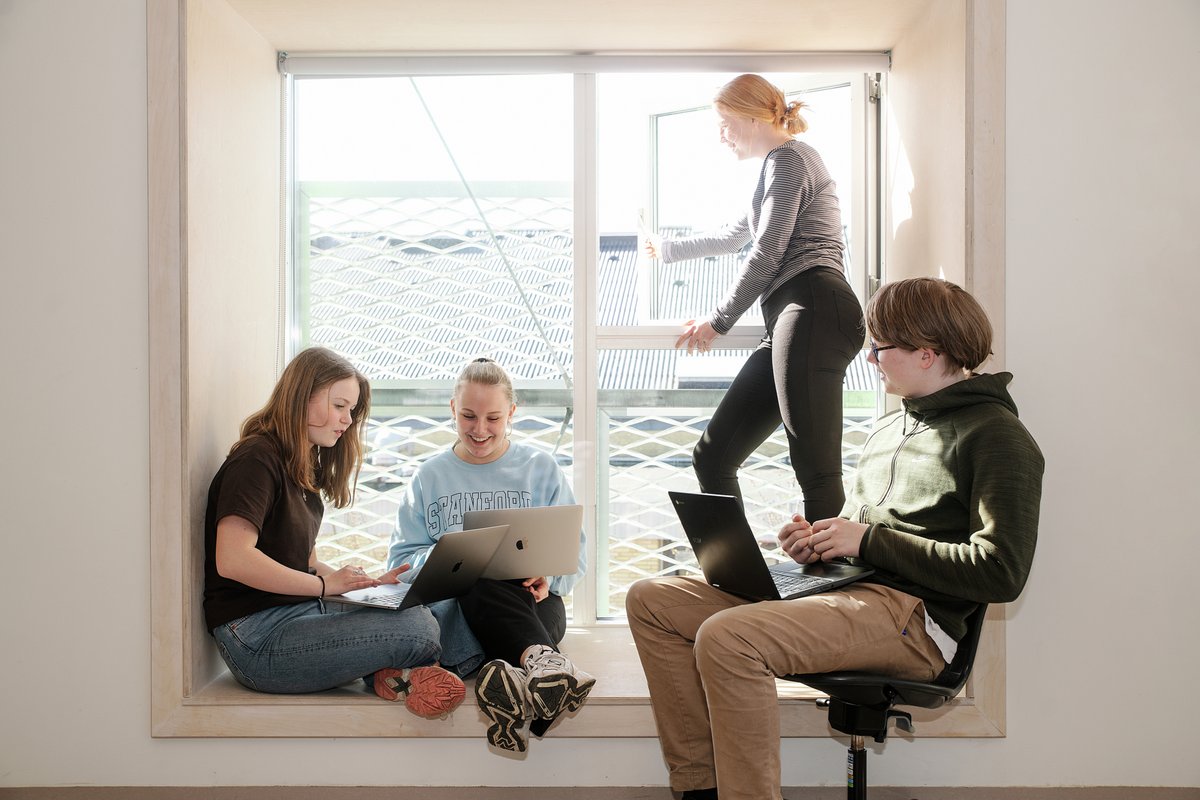Chemical substances impact the indoor climate in Danish classrooms
More than 450 different chemical substances are swirling around the air in Danish classrooms according to a new report from the large Mass Experiment on the indoor climate in Danish schools. Virtually all of the classes studied have concentrations above recommended levels.

Danish schoolchildren and their teachers are working in an unknown cocktail of chemical substances during school hours. A new mapping of the chemicals in classrooms has found more than 450 different volatile organic compounds (VOCs) in the air. Many of these contribute to poor air in classrooms.
The chemical substances primarily come from the pupils themselves; sweat, exhaled air, perfume, deodorant, and not least from hand sanitizer and from eating packed lunches during breaks. However, the actual rooms themselves, and their contents, also add to the chemicals in the air. The substances have names like butanoic acid, toluene and acetaldehyde. 15 per cent of the most frequently occurring substances are potentially harmful.
"Everything indicates that we’re facing a challenge with the indoor climate in Danish primary and lower secondary schools. CO2 levels are high, and we have also found high concentrations of chemical substances in the air," says Assistant Professor Kasper Vita Kristensen from the Department of Biological and Chemical Engineering at Aarhus University.
This is the first extensive examination of how much and what type of chemicals children and young people are exposed to in the air in Danish classrooms. This includes substances that smell and cause discomfort, and substances that are rarely noticed.
The study was conducted in 76 different classrooms in schools all over Denmark, at the same time as CO2 levels was studied during the Mass Experiment in 2021. The study was organised by the National Center for Science Education (ASTRA) and the Department of Biological and Chemical Engineering at Aarhus University. The project, Chemicals in the Air (Kemi i luften), is being funded by the philanthropic association Realdania and the VILLUM FOUNDATION.
(The article continues below the picture)
Pupils measured over four weeks
The pupils in the 76 participating classes set up sensors in their classrooms to measure the total amount of chemicals in the air every ten minutes for four weeks. The results were sent for analysis by the researchers, and they show that 96 per cent of the classes experienced concentrations of chemical substances above the recommended maximum level, although there was considerable local variation. Half of the classes had concentrations above the recommended maximum for one hour every day.
According to Kasper Vita Kristensen, the mapping shows that there is a need for much more research in the area.
"As yet, we know very little about the so-called cocktail effect when chemical substances are mixed together. Neither do we know much about how chemicals affect well-being and health, particularly among the children and young people who are in the rooms: often for very long periods at a time," he says.
Furthermore, Denmark still has no recommendations for the maximum number of chemical substances permitted in the air in classrooms. The recommendations stated therefore come from the German health authorities.
On the other hand, the Danish Working Environment Authority (WEA) has general threshold values for individual chemicals. The good news is that none of the potentially harmful substances found in the study exceeded these threshold values from WEA.
"No acute harmful chemical substances exceed the threshold values in the classrooms studied. But we find a lot of different chemical substances and several in concentrations that will contribute negatively to how the air in the classrooms is experienced. This is confirmed by the teachers' evaluations of air quality," Kasper Vita Kristensen says.
Ventilation helps
The study clearly shows that ventilation and airing-out helps. Classes with mechanical ventilation have significantly lower levels of chemical substances compared with classes with manual ventilation (airing-out). The classes with mechanical ventilation and that also air out manually, had the lowest average concentrations of chemicals during the measurement period.
“Ventilation is an effective way to remove heavy and bad-smelling air. But unfortunately, not all classes air-out sufficiently, and with the current energy crisis, with lowered classroom temperatures, mechanical ventilation may even be avoided, so the problem could quickly become more widespread," says Kasper Vita Kristensen.
"I fear that levels will increase this winter and air quality will fall in many Danish classrooms," he adds.
The air contains most chemicals in the afternoon when the pupils have been in the room for a long time. In particular, chemicals from the pupils’ packed lunches are in high concentrations on days with no airing-out. And the substances do not necessarily disappear when the pupils go home. There is a constant background level of chemical substances from gases emitted from the room itself, and cleaning also adds chemicals in the evening. If rooms are not aired-out or ventilated, many of the chemicals will stay in the air until the next morning.
First steps
Realdania has funded the study, and for several years the organisation has been working to improve the indoor climate in schools. Anne Gade Iversen, project manager at Realdania, says that the first steps have now been taken to learn more about which chemicals require action at schools and how.
"Measurements of CO2 levels have long pointed to insufficient ventilation in many Danish classrooms. The results of the Mass Experiment mean that we are now beginning to understand the consequences and hopefully we will increase focus on and knowledge about the many chemicals we experience when we are indoors," says Anne Gade Iversen.
Pupils themselves have helped
Pupils in primary and lower secondary schools have themselves helped to harvest the results by setting up sensors and collecting air samples. They have supplied a large amount of valuable data on the chemicals in the air in their classrooms.
"An important aim of Mass Experiment is for the pupils to try their hand at authentic scientific research methods so they can see what they have to do. Therefore, we also developed tools to guide pupils in their own behaviour. This means ensuring good habits regarding airing-out classrooms," says Lene Christensen, Master of Science and programme director for the Mass Experiment.
Within the next six months, the Chemicals in the Air study will be published at international level.
Summary
Mass Experiment 2021: Chemicals in the air in educational environments
- The chemicals in the air in teaching environments in Danish primary and secondary schools have been studied for the first time.
- In the experiment, 76 classes regularly measured levels of CO2 and the total amount of volatile organic compounds (VOCs).
- VOCs are found everywhere in the air, both inside and outside.
- VOCs are emitted from a wide range of sources, for example exhaled air from breathing, sweat, traffic, buildings, furniture and clothing, and from cleaning agents and lunch packs.
- TVOC stands for the total amount of VOCs. Recommended levels for the maximum amount of TVOC are often 750 ppb (parts per billion).
- The measurements were made every ten minutes over a minimum of four weeks in November 2021 using indoor climate sensors mounted in the individual classrooms.
- 53 classes collected air samples to analyse which specific VOCs were in their particular classrooms. The samples were collected on days with and days without extra airing-out and in the empty room.
- 43 teachers from 73 classes answered a supplementary questionnaire about airing-out, ventilation, and the experience of indoor air.
Results of the Mass Experiment:
- More than 450 different VOCs were found.
- 96% of the classrooms studied had at some point during the measurement period experienced TVOC concentrations above the recommended maximum level.
- 65% of the classes experienced TVOC concentrations above recommended threshold values for a quarter of the time or less.
- 10% of the classes experienced TVOC concentrations above recommended threshold values for more than a quarter of the time.
- 15% of the 60 most frequently occurring VOCs are classified as potentially harmful, but concentrations did not exceed the recommended maximum in any of the classrooms at the time of sampling.
- 38% of the 60 most common VOCs measured are associated with odour nuisance or discomfort.
- 100% of the classes experienced specific VOCs in concentrations above the odour limit.
- The higher the concentration of TVOC and these specific VOCs, the poorer the quality of the air experienced by the teachers.
- The surfaces of the classrooms emit VOCs and constitute a constant background level in the room.
- Activities in the classroom after school hours contribute to increased emissions of VOCs. Emissions from activities after school hours, e.g. cleaning, can still be measured the next day if there has not been sufficient ventilation or airing-out.
Recommendations:
- Air-out!
- A combination of mechanical and natural ventilation in the classroom prevents high concentrations of chemicals.
- Ventilation immediately after activities such as eating packed lunches is likely to have the greatest effect, but airing-out in the morning and shortly after the pupils return from physical exercise during break-time.
- If possible, the classroom should be empty during break-time.
Background about Mass Experiment:
- Mass Experiment is organised by Astra – the National Centre for Science Education. Mass Experiment is Denmark's biggest school experiment. A new experiment is developed in collaboration with researchers every year.
- The purpose of Mass Experiment is to offer pupils science teaching that they experience as motivating and close to real-life, with emphasis on authentic research methods. A secondary objective is for the pupils to be able to act on a scientifically informed basis.
- Mass Experiments in previous years have included focus on child incontinence, on plastic pollution, on children's sense of taste and on lactic acid bacteria. Several of the results have been published in recognised, international and natural science journals.
- The Chemicals in the Air study (Kemi i luften) is being funded by the philanthropic association Realdania and the VILLUM FOUNDATION.
Contact
Assistant Professor Kasper Vita Kristensen
Department of Biological and Chemical Engineering, Aarhus University
mail: kasper.kristensen@bce.au.dk
Tel.: +45 61968673
Lene Christensen,
Programme director for Mass Experiment
mail: lch@astra.dk
Tel.: +45 24881092

